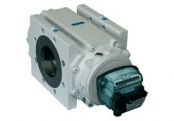Rotary Gas Meters – Selection of Common CGR Gas Meters
Published 25 Sep 2016

Metering
- By Chris Dodds : estimated reading time 3 minutes
T&D are UK Specialist Suppliers of gas meters from leading manufacturers including Itron and Common.
T&D can assist with selecting commercial, domestic and industrial gas meters with turbine, rotary and diaphragm types available. The following formula enables the correct selection and specification of Common CGR Rotary Gas Meters.
Rotary gas meters are positive displacement meters, designed to measure quantity of gas for custody transfer and technical gas measurement applications.
What is Gas Custody Transfer? Custody transfer occurs when gases are exchanged between operators; the amount of payment is usually calculated as function of the amount of gas transferred or as function of the amount of energy contained in the gas.
Rotary Gas Meters – Selection Formula
- Flow range Q min m and Q max m (m³/h)
- Pressure range p min m, and p max m (bar a)
- Gas temperature range (K)
Generally gas flow range is given at standard conditions : Q minN, and QmaxN (Nm³/h).
Base conditions (NPT conditions : normal temperature and normal pressure) are country specific depending on local regulations.
The following formula is to be used when converting standard flow cubic metres per hour into actual flow at operating conditions :
Q min m = Q min s •Z• Ps÷P max m • T min m ÷ Ts
Q max m = Q max s • Z • Ps ÷ P min m • T max m ÷ Ts

Thorne & Derrick – Metering & Specialists. Gas, Heat & Water Meters for Commercial & Industrial Applications – hazardous area flowmeters for hydrocarbons, liquids and gases
Definitions
Q min m = minimum gas flow at operating conditions m³/h
Q max m = maximum gas flow at operating conditions m³/h
Q min s = minimum standard gas flow (Nm³/h)
Q max s = maximum standard gas flow (Nm³/h)
Ps = base pressure (according to national standards – bar a)
Ts = base temperature (according to national standards K)
P max m = maximum operating pressure (bar a)
P min m = minimum operating pressure (bar a)
T max m = maximum operating temperature (K)
T min m = minimum operating temperature (K)
Z = real gas factor at operating conditions
The gas meter size should be chosen (using actual gas flow at operating conditions) according to the following formula :
Q min < Q min m
Q max > Q max m
where Q min and Q max – minimum and maximum flow, typical for the selected gas meter.
We hope you found this short article useful and informative – should you require any assistance with the selection of gas meters or gas flowmeters for hazardous area locations and potentially explosive atmospheres please contact us.
Invitation – network, engage, promote
Thorne & Derrick are inviting you to join LinkedIn’s fastest growing Discussion Group – Process & Hazardous Area Industries : Heat Tracing, Gas Detection, Fluid Control & Flow Measurement. News, projects, videos, promotions, whitepapers, jobs, webinars, press plus much more.
Further Reading
-
Common Rotary Gas Meters Brochure Size: 2.69 MB







